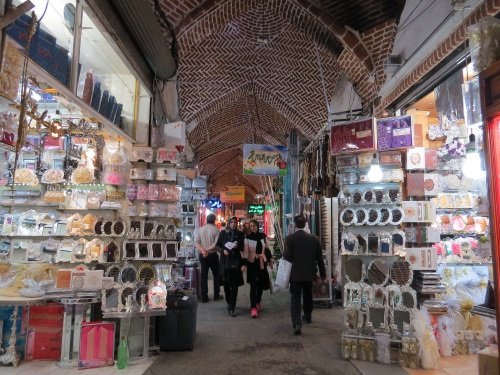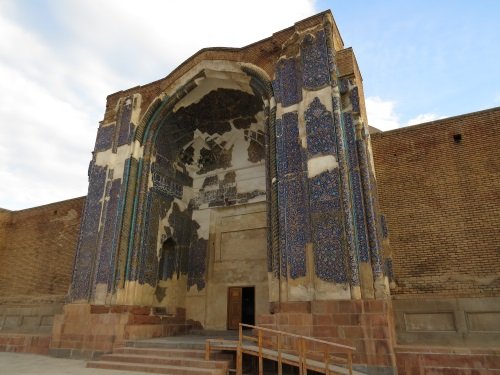The
Tabriz Historic Bazaar Complex
has been declared a WHS because of its original lay-out and architecture. The nomination file goes into extreme detail about Iranian bazaar types and customs, this apparently is “a central bazaar with radial gate-bazaars”. The 3 inscribed locations are the Grand Bazaar and 2 of the remaining secondary bazaars. It’s also one of the oldest bazaars still in use: Tabriz was already a bustling town in the 13th century, when it was an important commercial stop on the northern route of the Silk Road through Iran.

|
|
Shopping in the Bazaar
|
We arrived at the Grand Bazaar late in the afternoon. It still is a popular shopping district in this city of 1.5 million inhabitants, and many shoppers were about. Both modern necessities such as kitchen utensils and traditional goods like nuts and spices are sold. The figs especially are to die for, soft and sweet - nothing liked the dried-out objects you’ll find in supermarkets in Europe. Despite the bazaar’s age, it does feel quite modern and not as atmospheric as for example the medina’s of
Fez
and
Marrakech
. People in my tour group that had been to
Aleppo
, the most similar WHS because it’s also a covered bazaar, preferred that one over Tabriz too.
In the bazaar’s back alleys and behind closed doors there is however more to discover than appears at first sight. The bazaar not only has a commercial function, it provides social and religious roles too. We had a quick look into a huge covered caravanserai (
timcheh
). And we visited a sizeable, brick vaulted Shia mosque. Behind a curtain there we found some black ‘Ashura’ banners, used for the most important religious day in Iran. It’s the festival known for its bloody self-flagellation rituals, although this practice is discouraged in modern Iran.

|
|
Ashura banners in the mosque
|
Within the protected area of the Bazaar complex also lies the ‘Blue Mosque’ (which also mysteriously still features on Iran’s Tentative List). Looking at the UNESCO map it seems indeed connected to the Grand Bazaar, but in practice it requires a taxi ride from the bazaar to get to this mosque. Its renovated brick backside faces the main street, but when you walk to the other side a monumental gate like that of the masterpieces in Uzbekistan appears.
This mosque was built in the style of the Mongolian Timurid dynasty in the second half of the 15th century. Tabriz was at that time the capital of East Persia. The mosque has suffered badly during the past - an earthquake in 1779 largely destroyed it. On
19th century sketches made by passing European travelers
it is shown as virtually a ruin. Since then much brickwork has been added to make it whole again. But it is far from finished – according to our guide there is disagreement about how to proceed.

|
|
The Blue Mosque
|
Although certainly worth a visit for a couple of hours, Tabriz Bazaar was the least exciting of the 6 WHS that I visited during my tour of Northern Iran. But the name ‘Tabriz’ for me will forever be connected to the ‘Tabriz meatballs’. Ordering this from the menu in a touristy restaurant in Tabriz’s Luna Park, I expected to get something like
kofta
. But this is one
big ball of ingredients
, filled at its core with egg and chicken. With some difficulty I managed to eat half of it.



